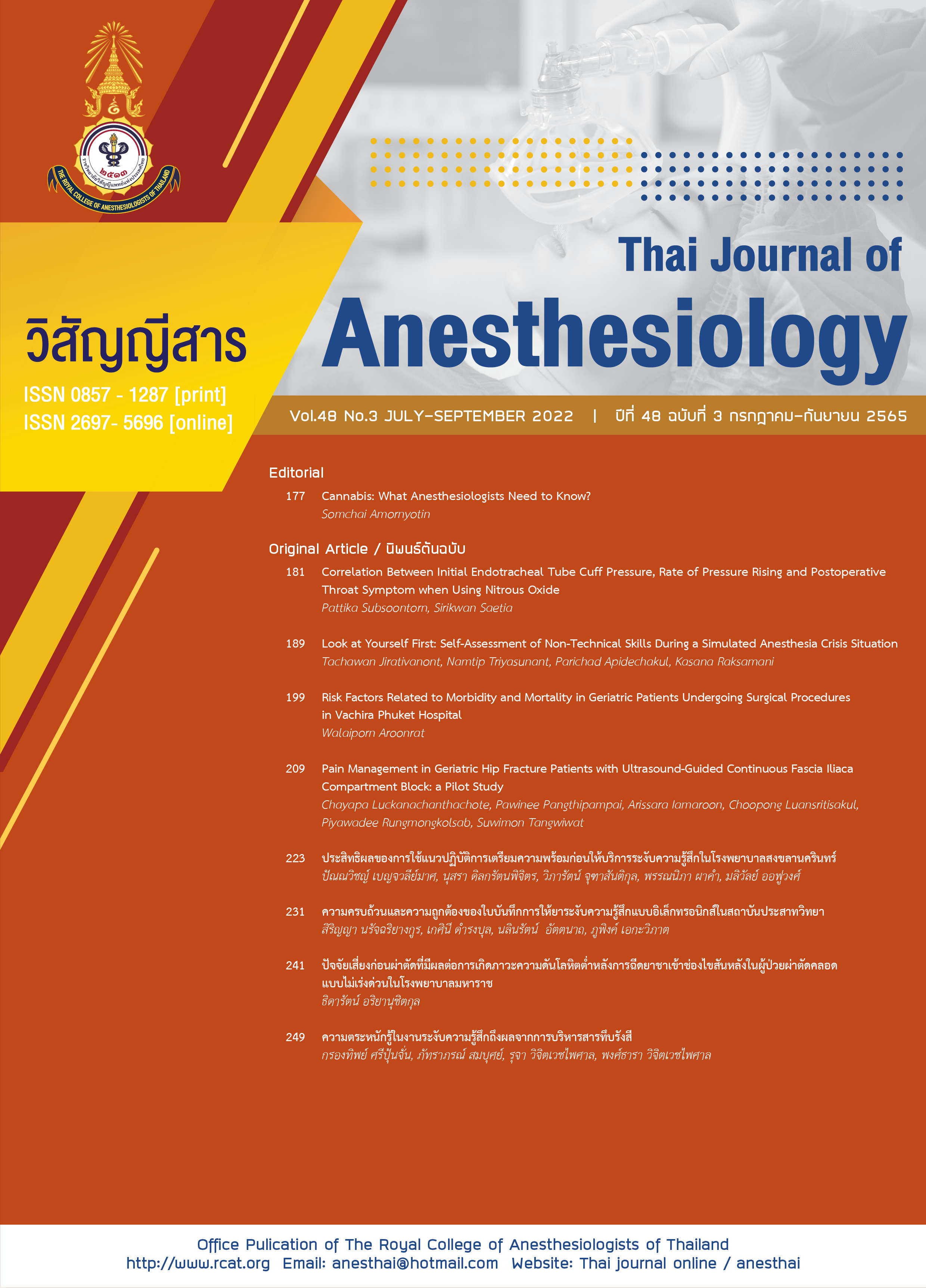Correlation Between Initial Endotracheal Tube Cuff Pressure, Rate of Pressure Rising and Postoperative Throat Symptom when Using Nitrous Oxide
Main Article Content
Abstract
Background: Inappropriate endotracheal cuff pressure inflation can result in post operative sore throat. Even with appropriate initial cuff pressure, nitrous oxide may increase the pressure. Objective: To assess the initial cuff pressure in routine pilot balloon inflation technique, rate of the pressure rising and correlation between cuff overpressure and throat symptom when using nitrous oxide. Method: One hundred and fifty patients scheduled for surgery under general anesthesia with expected surgical time more than 120 minutes were included. After endotracheal intubation, the cuff pressure was recorded at 0, 15th, 30th, 45th, 60th, 90th, 120th minute then every hour until extubation during 50% nitrous oxide administration. Postoperative sore throat and hoarseness were assessed at 1 hour and at 24 hours after extubation. The duration of operation and pilot balloon inflation technique were also recorded. Result: The initial pressures were within 20-30 cmH2O in 52.6% of patients. The incidence of intraoperative overpressure episode was 73.3%. The average rate of pressure rising was 3.9 cmH2O/h (IQR 0.6-12 cmH2O/h). The incidence rate of postoperative throat symptom was 48.6%. The duration of intubation more than 180 minutes (adjusted relative risk 4.8; CI 2.1-10.6, P<0.001) and any episode of overpressure (adjusted relative risk 7.3; CI 2.5-21.1, P<0.001) were the important factors that increase risk. Conclusion: With routine pilot balloon inflation, a high incidence of endotracheal tube cuff overpressure is occurred in most patients undergoing general anesthesia by using nitrous oxide. Intubation duration and episode of overpressure were the two important risk factors.
Article Details

This work is licensed under a Creative Commons Attribution-NonCommercial-NoDerivatives 4.0 International License.
References
Hamilton VA, Grap MJ. The role of the endotracheal tube cuff in microaspiration. Heart Lung. 2012;41:167-72.
Sengupta P, Sessler DI, Maglinger P, et al. Endotracheal tube cuff pressure in three hospitals, and the volume required to produce an appropriate cuff pressure. BMC Anesthesiology. 2004;4:1-6.
Biro P, Seifert B, Pasch T. Complaints of sore throat after tracheal intubation: a prospective evaluation. Eur J Anaesthesiol. 2005;22:307-11.
Inoue S, Abe R, Tanaka Y, Kawaguchi M. Tracheal intubation by trainees does not alter the incidence or duration of postoperative sore throat and hoarseness: a teaching hospital-based propensity score analysis. Brit J Anaesth. 2015;115:463-9.
Hockey C, Van Zundert A, Paratz J. Does objective measurement of tracheal tube cuff pressures minimise adverse effects and maintain accurate cuff pressures? A systematic review and meta-analysis. Anaesth Intens Care. 2016;44:560-70.
Manissery J, Shenoy V, Ambareesha M. Endotracheal tube cuff pressures during general anaesthesia while using air versus a 50% mixture of nitrous oxide and oxygen as inflating agents. Indian J Anaesth. 2007;51:24.
Vyas D, Inweregbu K, Pittard A. Measurement of tracheal tube cuff pressure in critical care. Anaesthesia. 2002;57:275-7.
Duarte NMC, Caetano AMM, Arouca GO, Ferrreira AT, Figueiredo JL. Subjective method for tracheal tube cuff inflation: performance of anesthesiology residents and staff anesthesiologists. Prospective observational study. Braz J Anesthesiol. 2020;70:9-14.
Combes X, Schauvliege F, Peyrouset O, et al. Intracuff pressure and tracheal morbidity: influence of filling cuff with saline during nitrous oxide anesthesia. Anesthesiology. 2001;95:1120-4.
Braz JRC, Volney A, Navarro LHC, Braz LG, Nakamura G. Does sealing endotracheal tube cuff pressure diminish the frequency of postoperative laryngotracheal complaints after nitrous oxide anesthesia? J Clin Anesth. 2004;16:320-5.
Ozer A, Demirel I, Gunduz G, Erhan O. Effects of user experience and method in the inflation of endotracheal tube pilot balloon on cuff pressure. Nigerian J Clin Pract. 2013;16:253-7.
Gilliland L, Perrie H, Scribante J. Endotracheal tube cuff pressures in adult patients undergoing general anaesthesia in two Johannesburg academic hospitals. South Afr J Anaesth Analg. 2015;21:81-4.
Ruananukun N, Kunawisarut K, Luetrakool P, Chantakul S. Comparison of endotracheal tube cuff pressure with minimal occlusive volume techniques. Thai J Anesthesiol. 2014;40:117-24.
Saracoglu A, Dal D, Pehlivan G, Gogus FY. The professional experience of anaesthesiologists in proper inflation of laryngeal mask and endotracheal tube cuff. Turk J Anaesthesiol Reanim. 2014;42:234.
Braz JR, Navarro LH, Takata IH, Nascimento Junior P. Endotracheal tube cuff pressure: need for precise measurement. Sao Paulo Med J. 1999;117:243-7.
El-Boghdadly K, Bailey CR, Wiles MD. Postoperative sore throat: a systematic review. Anaesthesia. 2016;71:706-17.
Hu B, Bao R, Wang X, et al. The size of endotracheal tube and sore throat after surgery: a systematic review and meta-analysis. PLoS One. 2013;8:e74467.
Jaensson M, Olowsson LL, Nilsson U. Endotracheal tube size and sore throat following surgery: a randomized-controlled study. Acta Anaesthesiol Scand. 2010;54:147-53.
Edomwonyi N, Ekwere I, Omo E, Rupasinghe A. Postoperative throat complications after tracheal intubation. Ann Afr Med. 2006;5:28-32.
Liu J, Zhang X, Gong W, et al. Correlations between controlled endotracheal tube cuff pressure and postprocedural complications: a multicenter study. Anesth Analg. 2010;111:1133-7.
Lee JY, Sim WS, Kim ES, et al. Incidence and risk factors of postoperative sore throat after endotracheal intubation in Korean patients. J Intern Med Res. 2017;45:744-52.
Puthenveettil N, Kishore K, Paul J, Kumar L. Effect of cuff pressures on postoperative sore throat in gynecologic laparoscopic surgery: an observational study. Anesth Essays Res. 2018;12:484.
Nseir S, Duguet A, Copin MC, et al. Continuous control of endotracheal cuff pressure and tracheal wall damage: a randomized controlled animal study. Crit Care. 2007;11:1-8.


